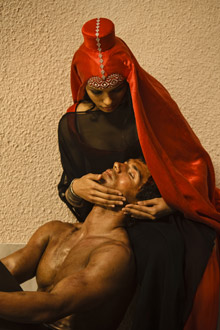
CARAVAGGIO MEETS FIGHT CLUB “Most people like a good script, and, unfortunately, I usually don’t start with that,” says Tarsem. “I start with a good visual.” |
The elevator pitch for Immortals was, in fact, "Caravaggio meets Fight Club." The Renaissance painter is a touchstone for Tarsem, going all the way back to "Losing My Religion," in which he recreates several of Caravaggio's paintings in tableaux. (When Tarsem references Caravaggio, though, he's also referencing Derek Jarman, the avant-garde English director whose biopic of the painter informs many of the shots in Immortals and whose Sebastiane, a landmark of gay cinema, features about the same amount of lovingly shot male torsos as Tarsem's film.)If Tarsem's commercials and videos are visual haiku, his movies are long-form poems that can't be read as prose. In them, each object is portrayed with hallucinatory detail, yet surrounded by a nebula of meanings: some symbolic, some metaphorical, some deeply personal and only glimpsed.
Genealogy
In another of Tarsem's videos, Deep Forest's "Sweet Lullaby," a little girl is traveling the world on her tricycle, searching for something, looking at people through a wooden square — a viewfinder. When he made that video in 1994, Tarsem was doing much the same. His work shooting commercials had him constantly traveling, and wherever he went he'd send talent scouts into the local schools. He was looking for the right little girl for a movie he had in mind.
"Something happened to me that doesn't happen to most people," Tarsem told Roger Ebert in 2008, after The Fall came out.
His life had been proceeding like everyone else's, he said. "But at the particular point when I was ready to settle down with a woman and have the babies, the woman moved and had the babies with somebody else." Instead, he made The Fall, funding it out of his own pocket. "I had no idea who my money was for," he said in the same interview. "It wasn't for the kids that I didn't have."
It took four years, shooting at locations around the world. His star, when he finally found her after nearly a decade of searching, turned out to be a six-year-old Romanian, Catinca Untaru, who spoke no English. Opposite her was Lee Pace, then nearly unknown, whom Tarsem had seen in Soldier's Girl playing a transexual woman and persuaded to take on the project.
Pace's character, Roy, is a stuntman in 1915 Hollywood who has been paralyzed in a fall. But he is also suffering from a broken heart: his girlfriend has left him for another man. In despair, he first seduces the little girl with his storytelling, then tries to make a murderer of her. After she is badly hurt trying to steal morphine for him, he comes to her, contrite, but still suicidal. She begs him to finish the story and, weeping, he does, killing each character off in images both horrifying and beautiful.
But it is her story too. She casts him as the hero, herself as the hero's daughter. "No more killing," she pleads. And Roy finally has to comply. We never find out what really happens to Roy. I imagine he goes on to become a director.